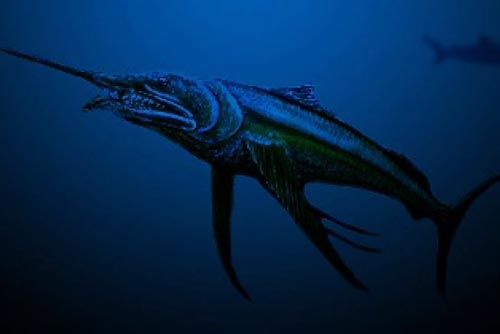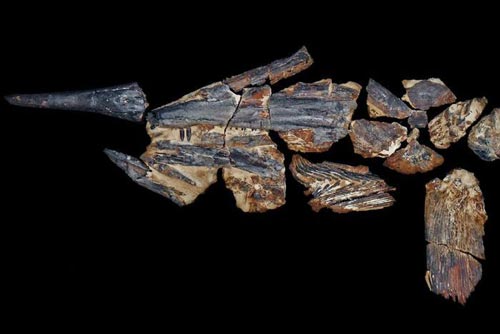Australopachycormus hurleyi – Rare Fossils Found
The fearsome marine reptiles that once inhabited the Western Interior Seaway of North America led to this shallow, Cretaceous-age, inland sea being described as “Hell’s Aquarium”, but at the same time much of the land we know now as Australia was covered by an equally dangerous marine environment.
Amongst the myriad of marine reptiles, cephalopods and other exotic creatures, a three-metre fish with a head like a swordfish and dagger-like teeth swam. Thanks to two sharp-eyed families scientists have more fossils of this fast-swimming predator to study.
An Illustration of the Giant Predatory Fish Australopachycormus hurleyi
Picture credit: Dr Patrick Smith
The Importance of Amateur Fossil Hunters
It is thanks to two families that scientists have some more of these extremely rare fossils to study. Australopachycormus was a member of an extinct, diverse group of fishes called the Pachycormidae, first described in 2007 from fossils found some several hundred kilometres south-west of the new discoveries.
This group of fish, believed to be basal to the teleosts, evolved into a number of forms including plankton-eating giants such as Bonnerichthys and Leedsichthys. Australopachycormus hurleyi was the first of the Pachycormidae to have been found in Early Cretaceous sediments in the Southern Hemisphere, it was not a gentle filter feeder, it would have been a fast swimming, active pursuit predator most likely preying on smaller fish species.
To read an article from 2010 that looks at some of the giant members of the Pachycormidae: Giant Bony Fish Swam in Prehistoric Seas.
An almost complete snout (rostrum) was found by the Johnston family and then, about a week later, the Amos family were walking in the same area and they discovered elements from the skull, backbones, teeth and portions of the front fins.
A spokesperson from Everything Dinosaur commented:
“Tourists and amateur fossil hunters have made a huge contribution in this part of the world. Fossils are often brought to the surface as agricultural machinery prepares the soil for crops and it is thanks to keen-eyed walkers that many rare and scientifically significant fossils have been found.”
Visit Everything Dinosaur’s award-winning website: Everything Dinosaur.
Australopachycormus hurleyi
Staff from Kronosaurus Korner, a local fossil museum helped to identify the specimens.
The Fossils Are United in a Single Specimen
Picture credit: Dr Patrick Smith
Dr Patrick Smith, the curator of Kronosaurus Korner explained that thanks to these two families an outline of the skull, the anterior part of the body and that long sword-like rostrum had been assembled.
Dr Smith stated:
“We know that it was a high-tier carnivore and that it ate other large, fast-moving fish, a bit like marlin do today. Because it does fit that swordfish-like shape we know he [Australopachycormus] probably lived in that same ecological niche”.
The bony rostrum would have been used as a weapon to stun potential prey before they were snapped up in those formidable jaws. Dr Smith said he wanted to encourage other amateur palaeontologists and tourists to make their way to the tiny outback township of Richmond, as there were plenty of other amazing fossils just awaiting discovery.
What Does Australopachycormus hurleyi mean?
Whilst compiling this article Everything Dinosaur was emailed and asked how this ancient fish came to be called Australopachycormus hurleyi? The genus name reflects the fact that despite being a very numerous group of prehistoric fishes, Australopachycormus was the first Early Cretaceous pachycormid to be found in strata from the Southern Hemisphere. The genus name means “southern pachycormid”. The species name honours Tom Hurley who found the holotype material near Boulia in central, western Queensland when exploring the Toolebuc Formation of the Rolling Downs Group (Eromanga Basin).
So, if the Western Interior Seaway is known as “Hell’s Aquarium” we shall have to think of a suitable colloquialism to use when describing the marine biota of Queensland during the Cretaceous.
Suggestions would be most welcome.
For models and replicas of ancient sea creatures and sea monsters: Models of Ancient Sea Creatures, Dinosaurs and Prehistoric Animal Figures.








Leave A Comment